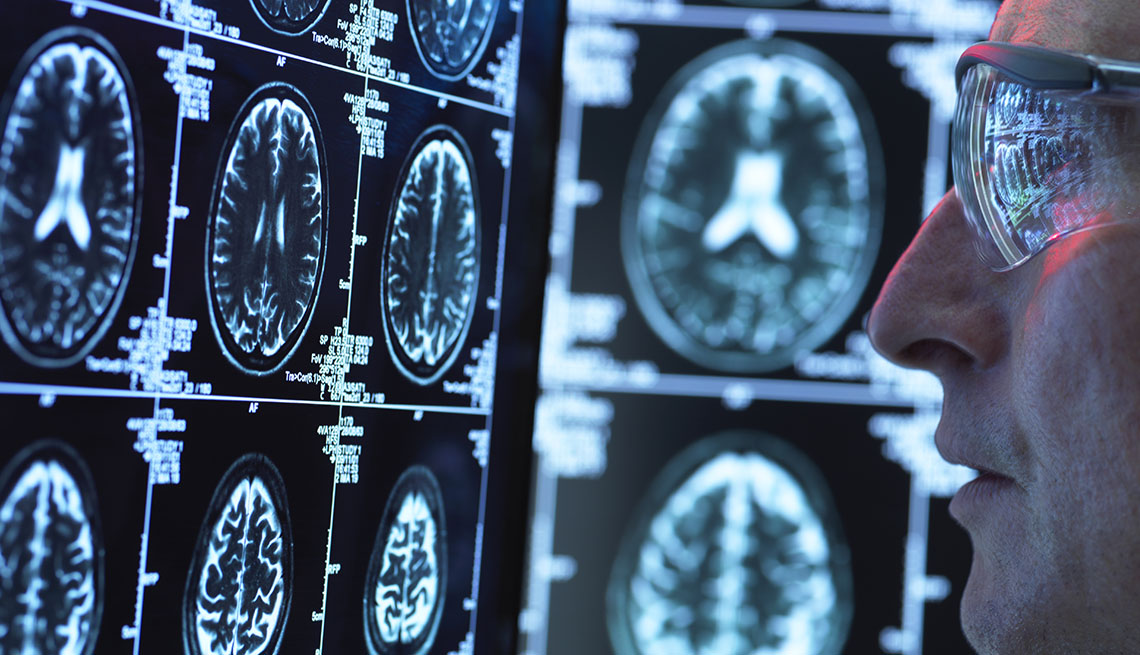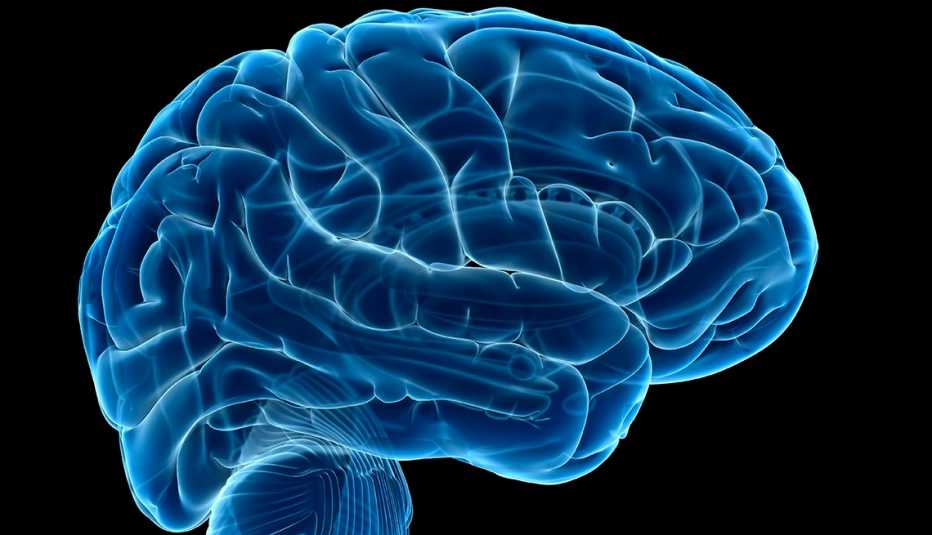Staying Fit
It's perfectly normal to occasionally forget someone's name or where you parked the car. But for many older adults, those moments of forgetfulness foster a deeper fear: Could they be an early sign of Alzheimer's disease?
Alzheimer's is a progressive, fatal brain disorder that slowly destroys memory and thinking skills, eventually affecting your ability to carry on a conversation and function independently.


AARP Membership— $12 for your first year when you sign up for Automatic Renewal
Get instant access to members-only products and hundreds of discounts, a free second membership, and a subscription to AARP the Magazine.
About 5.8 million Americans live with the illness, according to the Centers for Disease Control and Prevention (CDC). And that number is projected to nearly triple over the next few decades, to 14 million people by 2060.
Alzheimer's disease and dementia are not the same. Dementia is a catch-all term that describes any cognitive decline severe enough to interfere with daily living. Alzheimer's is the most common type of dementia. It's specifically characterized by the buildup of amyloid plaques and tangled fibers called tau in the brain and by a loss of connections between nerve cells.
In most people with the disease, symptoms first appear after age 60. But Alzheimer's is not just a condition of old age. Approximately 200,000 Americans under age 65 have the disease (also known as early-onset Alzheimer's).
Although medical management can improve quality of life, there is no known cure for Alzheimer's. It is the sixth leading cause of death among U.S. adults and the fifth leading cause of death among adults 65 and older.
To help address this enormous health challenge, federal funding for dementia and Alzheimer's disease research has surged in recent years, to $3.1 billion in 2020. Experts say many promising diagnostics and treatments are being developed and tested.
Risk factors to know
Age Advancing age does not cause Alzheimer's, but it is the greatest known risk factor. About 1 in 9 people 65 and older have Alzheimer's dementia. After age 65, the risk doubles every five years, and about a third of people older than 85 have the disease. Scientists are still studying how age-related changes in the brain may contribute to Alzheimer's progression.
Genetics Anyone who has a parent, brother or sister with Alzheimer's is nearly twice as likely to develop the disease, and those who have two first-degree relatives with Alzheimer's have almost four times the risk. Even if your parents and siblings don't have the illness, having second- or third-degree relatives with Alzheimer's increases your risk, according to a 2019 study published in Neurology. Researchers have not found a specific gene that directly causes Alzheimer's, but they have identified a gene called APOE e4 that raises risk. It occurs in about 40 percent of people who have the disease.
Race and ethnicity African Americans are about twice as likely to develop Alzheimer's as Caucasians; Hispanics are about 1.5 times more likely. Their greater risk may be related to these groups’ higher rates of cardiovascular disease, researchers say.
Poor cardiovascular health A growing body of evidence has linked the risk of developing Alzheimer's to many conditions that damage the heart and blood vessels, including heart disease, diabetes, stroke, high blood pressure and high cholesterol. On the plus side, taking control of your health may reduce your odds of dementia. Some studies have found that taking medication to control blood pressure and cholesterol can reduce dementia risk.
Ask the Expert
Q&A with Beth Kallmyer, vice president of Care and Support for the Alzheimer's Association
What are some misconceptions about Alzheimer's disease?
People think that Alzheimer's is only about memory loss. While memory loss is an early symptom, other symptoms include loss of judgment, loss of executive function and the inability to track not just conversation but the actual steps in a process of a regular habit, like getting dressed or making breakfast.
The other really big misconception is that once you have Alzheimer's, you can't communicate and you don't remember anybody. It's not something that happens all at once. Now that science has progressed, people can be diagnosed in the very early stages. It might not be obvious they have the disease.
How can I tell if it's Alzheimer's disease or just normal age-related memory loss?
Normal forgetfulness happens to all of us. What you should be concerned about is if you have one of those forgetful moments and you can't track back in time. So if you lost your keys and then you eventually find them in the den, you might say, “Oh, yes, I came in here to water that plant.” But if you have no memory of putting them there and you think someone moved them, that's more of a cause for concern. Another reason for concern is if you're forgetting really important things. So, for example, someone who always remembers their grandchildren's birthdays can't remember them. Or someone who never misses appointments starts missing them. What you want to look for is a significant change in normal behavior.
How can I lower my risk of Alzheimer's disease?
A growing body of research shows you can make lifestyle changes to reduce your risk. Exercise. Eat right. Manage your cholesterol and blood pressure numbers. Stay engaged. It may not sound exciting, but there's good evidence to show those things make a difference.
These Q&As have been edited for length and clarity.
Early symptoms
Here are some early warning signs of Alzheimer's disease, according to the Alzheimer's Association:
- Difficulty with everyday tasks Struggling to do things that were once easy, such as paying bills, remembering the rules of a familiar game or following a favorite recipe
- Communication problems Asking the same question again and again, getting lost during a conversation or forgetting the name of a close friend or relative
- Confusion about time or place Losing track of dates, seasons and the passage of time; getting lost while driving to a familiar location; or forgetting where you are
- Misplacing things or putting them in unusual places Losing things or putting them somewhere odd and then being unable to retrace your steps to find them; people with Alzheimer's may accuse others of stealing, especially as the disease progresses.
- Mood or personality changes Withdrawal from social activities, acting quieter or more argumentative than normal or becoming confused, suspicious, depressed, fearful or anxious
Getting a diagnosis
If you or a loved one is experiencing memory loss, it's important to see a doctor, says Michael Weiner, M.D., principal investigator of the Alzheimer's Disease Neuroimaging Initiative, the largest observational study of Alzheimer's disease in the world.
It's possible that your symptoms may not be due to Alzheimer's but to some other treatable condition, like thyroid disease or a vitamin deficiency, Weiner says.
If it is Alzheimer's, an early diagnosis gives you more access to treatment options and a chance to make lifestyle changes, such as controlling blood pressure and exercising, that may help preserve your cognitive function. It also allows you more time to plan for the future and enjoy meaningful activities with the people who are important to you.
Right now, the gold-standard method to diagnose Alzheimer's is a type of scan that measures amyloid deposits in the brain. Another option is a spinal tap that can gauge amyloid levels in the fluid surrounding the brain and spinal cord.
These tests aren't used to diagnose most patients, though, because they're expensive and often not covered by insurance. Instead, most physicians use medical history, other types of brain imaging, memory tests, and physical and neurological exams to make a clinical diagnosis.
New blood tests may help with early detection
Among the most exciting news in the Alzheimer's field is the development of simple blood tests to detect the disease, reducing the need for an expensive brain scan or invasive spinal tap. The new tests also potentially make it possible to detect the changes in the brain before symptoms appear.





































































